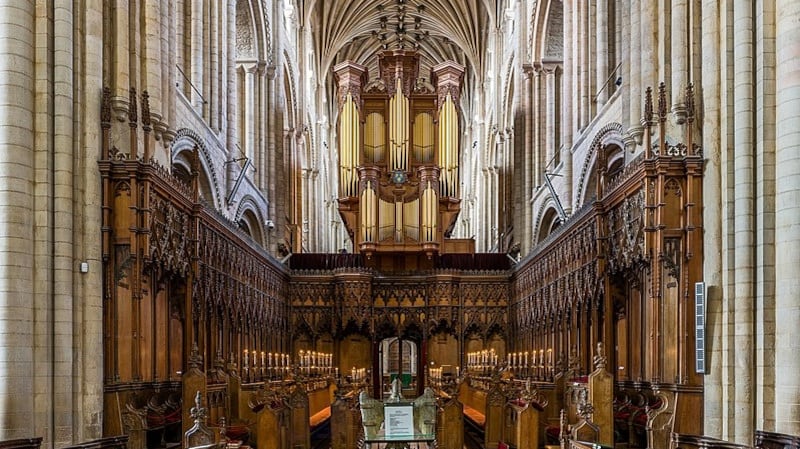Irish place names can be found across the world and often provide us with unique insights into Irish migration patterns. From the uninhabited township of Kilkenny in the White Mountain National Forest in New Hampshire to the sandy shores of Fingal Bay, New South Wales, they each tell their own story, and help us to piece together the histories of our 70 million-strong diaspora. Occasionally, streets, plazas, towns, ships and even lunar craters have also been named after prominent Irish emigrants in recognition of their achievements and legacies. Lefroy Road, in suburban Norwich in England is one such place.
Named after the Reverend William Lefroy, the one-time Dean of Norwich Cathedral, this quiet, leafy street commemorates an Irishman who certainly left an impression on all those he encountered. A man with a varied life - at one time or another Lefroy was a journalist, pastor, alpinist, freemason, author and teacher.
Born to a well-known, if not affluent, family in Dublin in 1836, the young William benefitted from an excellent education which enabled him to study at Trinity College, Dublin. In order to finance his studies, he undertook an apprenticeship as a printer for the fledgling Irish Times, later becoming a journalist and sub-editor with the newspaper before stepping down ahead of his ordination in 1865. While he continued his studies, he was appointed curate of Christ Church in Cork before leaving Ireland in 1866 to take up the position of vicar of St Andrew’s church in Liverpool.
Lefroy remained in Liverpool for the next two decades and involved himself in the life of the city and his parish. Throughout the 19th century the city continued to steadily expand as its dockyards and their related industries attracted immigrants from Ireland, Greece, Germany, Scandinavia and further afield. The vicar established relationships with the wealthy merchants of the city, which allowed him to raise more than £100,000 in donations from his new found supporters. In what was a relatively poor parish, he put the funds to good use, supporting schools and children's services, improving the condition of the church buildings and attracting new parishioners to his weekly services.

Shortly after his arrival in Liverpool, Lefroy began to take a keen interest in mountaineering, spending his summers in the Mattertal valley in southwestern Switzerland from 1867 onwards and eventually joining the Alpine Club, the world's first mountaineering club, which was founded in 1857. While there he raised funds for the construction of Anglican churches in Switzerland for the English seasonal visitors and took a keen interest in their administration. The vicar married twice, though little is known of his first wife. He wed his second wife Mary Ann MacIver in Malta in 1878 and they had two daughters.
In 1889 he received his doctorate of divinity from Trinity College Dublin before moving to Norwich to become dean of its cathedral, a role he would retain until the end of his life
In England, as word of his achievements spread, Lefroy gained prominence among the more influential members of the city and he helped bring about the creation of a new diocese, the bishopric of Liverpool, in 1880. In recognition for the part he played in the formation of the diocese he was appointed an honorary canon by its first bishop, Dr Ryle. Further promotions followed for Lefroy over the next few years, and he became dean of Liverpool South in 1884, archdeacon of Warrington in 1887 and the Donnellan scholar of Trinity College Dublin in the same year. While at Trinity, he published the first of the four books he would author in his lifetime, The Christian Ministry: Its Origin, Constitution, Nature, and Work. In 1889 he received his doctorate of divinity from the college before moving to Norwich to become dean of its cathedral, a role he would retain until the end of his life.
Once settled in Norwich, Lefroy immediately set about improving the standing of the church locally. He abolished pew rentals, which led to an increase in church attendance and then set about fundraising for the restoration of the cathedral itself. At the age of 63 he became interested in freemasonry and would go on to serve as the povincial grand vhaplain of Norfolk and, later, grand chaplain of the United Grand Lodge of England. Lefroy died at the age of 73 in 1909 during a visit to his beloved Alps and was buried in the ground of the Holy Trinity church in Riffelalp, Switzerland, a church he himself had opened 25 years earlier.
A lesser known but compelling figure, Lefroy was an excellent fund-raiser, a charismatic public speaker and a man well able to bring people together for a common purpose. He ensured schools and community works were built and aided in the reorganisation of the Church of England during a period of great change. The churches he helped to repair and establish in Britain and Switzerland stand as testaments to his will and determination.
This Extraordinary Emigrants article was written by Nathan Mannion, senior curator of Epic: The Irish Emigration Museum, in Dublin’s Docklands, an interactive museum that tells the story of how the Irish shaped and influenced the world




















